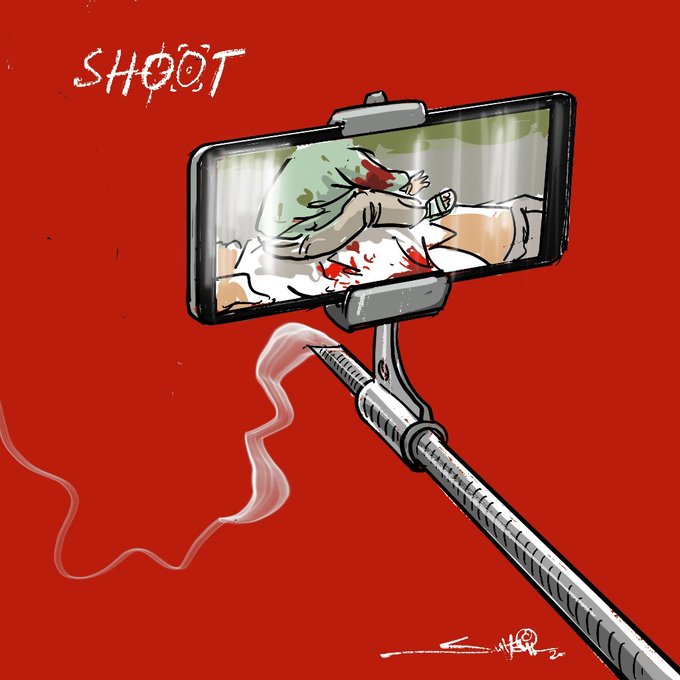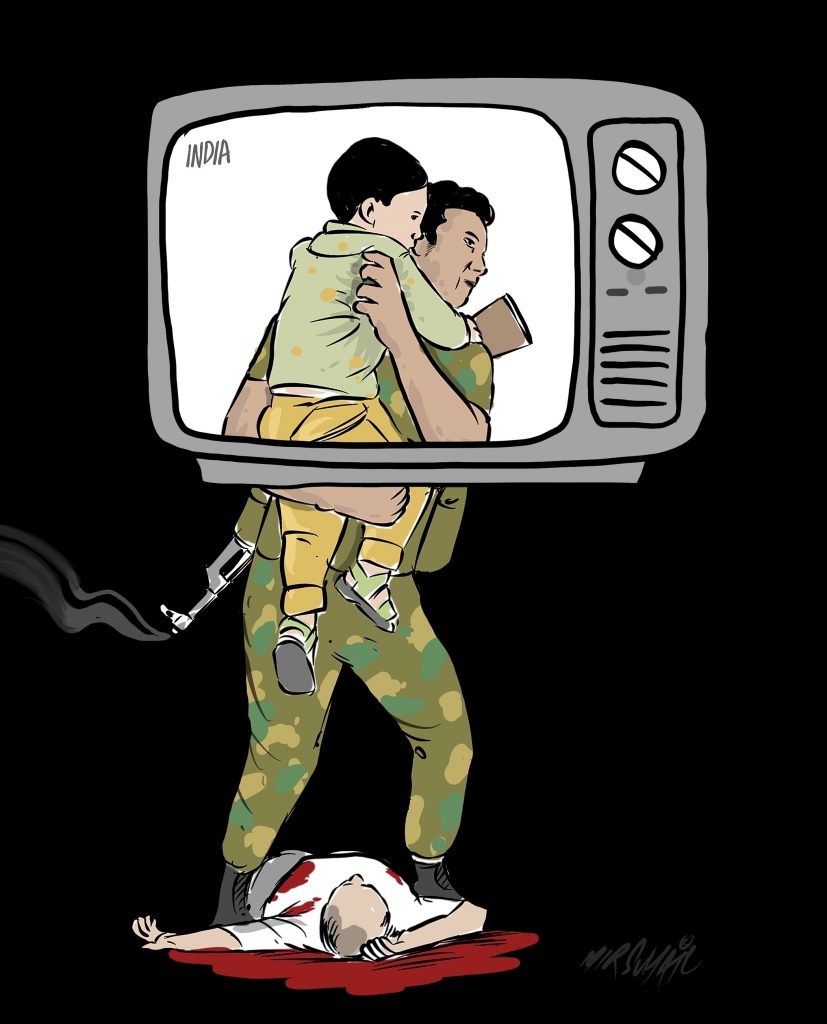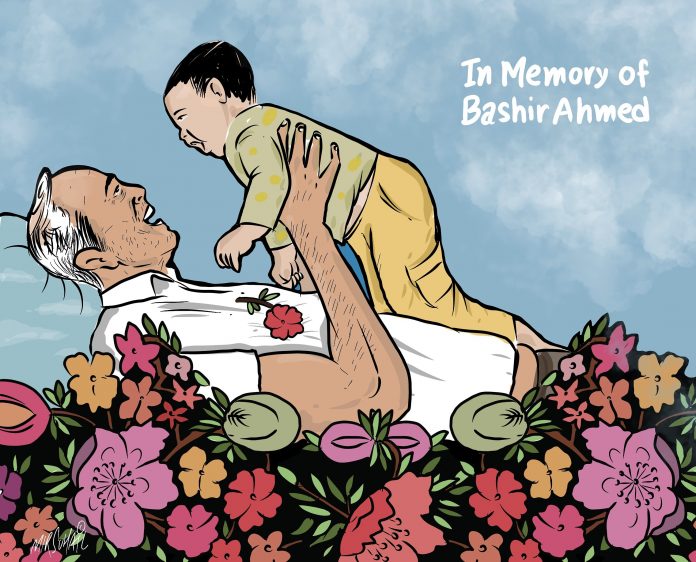Majid Maqbool, TwoCircles.net
The flurry of gory images of a three-year-old child atop his dead grandfather, his arms stretched backwards, after losing his life during an alleged shootout at Model Town in northern Kashmir’s Sopore area on Wednesday, also pained Kashmir’s artists and cartoonists. Their telling illustrations and cartoons show how the tragedy of the child was exploited and used by a pliant media and politicians from the ruling regime to serve their anti-Kashmir narrative.
Noted political cartoonist and painter Suhail Naqshbandi in his illustration on the incident, which went viral on social media, showed a mobile camera attached to the nozzle of the gun in a red background. The attached camera is shooting the images of the terrified toddler on the dead body of his grandfather.
Naqshbandi said the killing of a five-year-old in Anantnag last week and now the images of the terrified child on his dead grandfather made him anxious and worried as a parent. He couldn’t look at all the images and videos that were shared throughout that day on social media.

“Using kids to make a nefarious narrative is savagery. These back to back gruesome incidents mark a new low in the seemingly never-ending tragic saga of Kashmir,” rues Naqshbandi.
He said using the dead grandfather’s three-year-old grandson as a prop for the hurriedly done macabre photo shoot is beyond his thinking.
“Joseph Goebbels, if alive, would have had a thing or two to learn from this violent spin-doctoring. It took me a lot of time to wrap my head around this whole incident and as an artist, I had many facets of this incident in mind,” he said adding that what he found striking was the double act of shooting – with the gun and then with the camera.
“So this piece of work is focused on that. But unlike other times, when I am done with making art which acts as my catharsis, this time the feeling of uneasiness is not settling,” he said. One of the kid’s videos shows him gesticulating a gun with his little finger while saying “thak thak.”
“That finger also acts as a finger of being a Shahid, a witness,” said Naqshbandi. “He is a witness to that trauma which no kid should ever see and we also remain witnesses to his innocent truth.”
In his viral cartoon for a local newspaper, political cartoonist S. Tariq replicated an image of the terrified three-year-old child with bloodstains on his clothes. Instead of tears, blood is dripping from his eye. The illustration is captioned: “mustaqbil roie ga bi kyse?” (How could future cry?)

“The incident which took place in Sopore is a routine in Kashmir. We are used to such things but the careless way in which the heartrending pictures of that innocent kid were released shocked me,” said Tariq. “It also puts a question mark on the humanity of those who shot and released these pictures.”
Tariq said he couldn’t stop his tears after seeing those images. The plight of the terrified child shook him. He felt restless and thought about the past, present and future before drawing the cartoon.
“In this cartoon, I tried to depict the scared and bloody childhood of children of Kashmir which is being snatched again,” said Tariq. “The cartoon reflects the future of our children. The child is also crying for his future and our future.”
Political cartoonist Mir Suhail, who is presently based outside India, woke up to see his social media timeline full of heartrending images of the child and his grandfather lying dead on the roadside. The child atop his grandfather whose images were taken before his grandfather could have been rushed to the hospital pained him. He was angered by how the images of police “rescuing” the child were shared by official social media accounts and later picked up by the media and few journalists who gave it a spin without knowing the reality or questioning how these images were clicked.
“I saw how Kashmiris were demonized again and the trauma of this kid was used to suit their agendas,” said Suhail.
He came up with a cartoon that questions the framing of the tragedy. It shows a policeman in a television frame ‘rescuing’ the child while beneath him, and outside the frame, lies the dead body of his grandfather in a pool of blood – unattended.
Suhail believes there’s no accountability for civilian killings in Kashmir and nobody is allowed to question the state on the plight of people.
“Nobody even asks for probes anymore and there is no freedom of expression there,” said Suhail adding that he wanted to show how most of the Indian media shows one side of the story – that serves their narrative – when it comes to Kashmir.
“I’m worried about how the trauma of the kid, in this case, was used to peddle the state narrative,” said Suhail.
In another moving illustration titled “in memory of Bashir Ahmed”, Suhail showed the smiling grandfather surrounded by flowers and holding his grandson in his arms. He is playing with the child as before as if he has been reunited with his grandson.

“Before drawing this, I was thinking of how the kid would have been enjoying his time with his grandfather and how within moments everything changed and he bled to his death on the roadside in presence of his grandson,” the cartoonist said.
“I can imagine many grandfathers back home who would have hugged their grandchildren after seeing those haunting images,” Suhail adds with a sigh. “This boy is scarred forever and he will never get to hold his loving grandfather’s hand again. That thought is killing me.”


